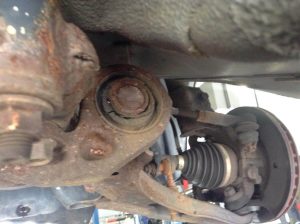Is Your Suspension System Failing? This Could Be Why
 Control arms, bushings, and ball joints are very important components of the suspension system. These parts allow a combination of flexibility and controlled movement over rough road conditions and adjust according to the steering input from the driver. If these parts become worn, they can compromise handling and comfort, or result in catastrophic damage to your vehicle. Here are a few of the most common problems that can arise within your suspension and steering, along with our best tips for prevention:
Control arms, bushings, and ball joints are very important components of the suspension system. These parts allow a combination of flexibility and controlled movement over rough road conditions and adjust according to the steering input from the driver. If these parts become worn, they can compromise handling and comfort, or result in catastrophic damage to your vehicle. Here are a few of the most common problems that can arise within your suspension and steering, along with our best tips for prevention:
Bushings
As we often say, bushings in your car's suspension system are similar to cartilage in your body's bone structure. They cushion the suspension system which helps to controls noise and vibrations, and provides a softer ride over bumps. Just as worn or damaged cartilage results in "bone on bone" contact and discomfort, worn or damaged bushings can allow metal on metal contact— and subsequently uncomfortable rides. This creates tire wear, strange noises, and funky vibrations. Bushings typically deteriorate due to heat, age, exposure, heavy loads, salt, oils, and the stress of frequent movement.Ball Joints
Ball joints are another common culprit in failing suspension systems. There is not exact lifespan on sealed ball joints, but they can fail as early as 80,000 miles, or even earlier in some vehicles, depending on your driving style. Like the ball and socket joint that connects your leg to your hip, a control arm’s ball joint connects and holds the front suspension of your vehicle together. Just like your hip joint facilitates leg movement, a ball joint enables the wheel and suspension to move together in the same manner. It’s important to watch for signs of ball joint failure and address them in a timely fashion. If a ball joint fails completely it can cause a complete loss of control, putting you and any passengers in serious danger. Typically, the tire will be at an angle, and the vehicle will come to an abrupt halt. This could damage the wheel and tire, other suspension components, and possibly even other parts of the vehicle.The Signs and Symptoms
There are many signs of a failing ball joint or control arm bushings including:- Clicking, popping, or snapping sound when the wheel is turned. Eventually, the clicking and popping can turn into a squeaking sound at the end of a stop, when the gas pedal is used, and/or when turning the steering wheel.
- A significant shift in the vehicle’s steering alignment, which may cause the steering to pull to the side. This will require constant correction to steer the vehicle straight.
- Knocking or clunking noises coming from the suspension when going over bumps. The sound will continuously get louder as the component wears or eventually breaks.
- Worn bushings or ball joints can cause wheel shimmy, which may cause vibrations that are felt in the steering wheel. Vibrations may increase during acceleration and smooth out at higher speeds.
- Dry ball joints usually have dramatically increased friction and can cause the steering to stick or be more difficult.
